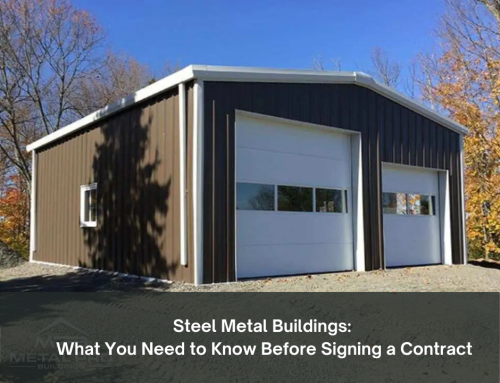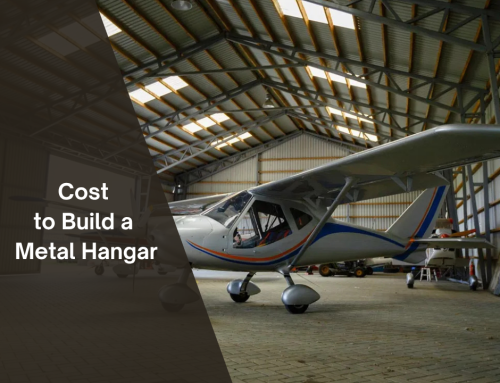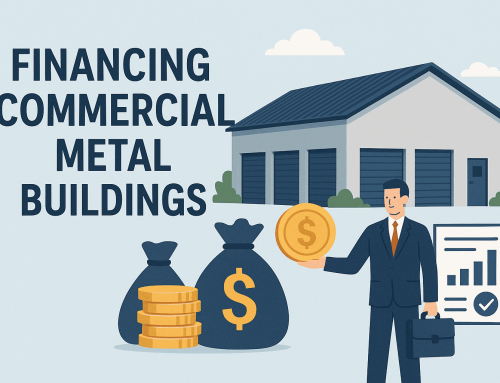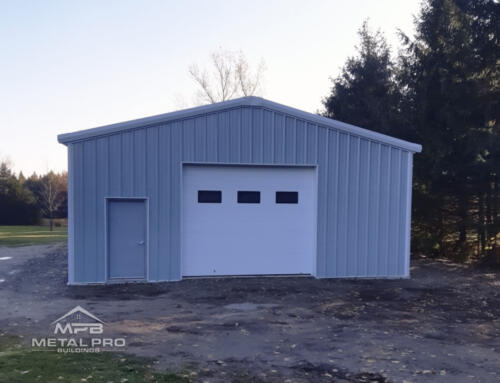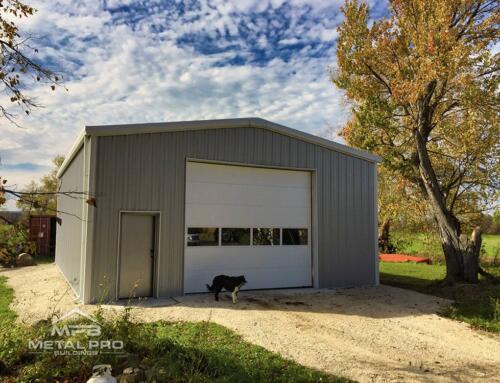It sounded like a freight train barreling through the neighborhood. That’s how many tornado survivors describe the moment the storm hit. In just seconds, roofs can vanish, walls may collapse, and entire buildings are torn apart. If you live in a tornado-prone area, one question naturally comes to mind: will my building survive a direct hit?
This concern is especially common among those considering a metal building whether it’s for a home, garage, warehouse, or workshop. With so many stories about storm destruction, it’s fair to wonder: are metal buildings strong enough to handle a tornado, or are they just fancy tin cans waiting to fly away?
In this article, we’ll explore exactly how tornadoes affect structures and how well-engineered metal buildings respond under pressure. We’ll look at real-life examples, compare metal with other common materials, and break down the safety features, codes, and warranties that help protect what matters most.
What Happens to Buildings During a Tornado?
Tornadoes are among nature’s most violent forces. They produce swirling winds that can reach over 300 km/h (190+ mph) in extreme cases. But it’s not just the speed of the wind that causes destruction, it’s how it interacts with buildings.
When a tornado hits, three main forces come into play: uplift, pressure, and impact from debris. Uplift can rip roofs clean off, while sudden changes in pressure can blow out walls and windows. Meanwhile, flying debris like tree branches, metal parts, or even other buildings acts like missiles, slamming into anything in its path.
Here’s a breakdown of tornado strength using the Enhanced Fujita (EF) Scale, which shows what kind of damage each level can cause:
| EF Rating | Wind Speed (mph) | Expected Damage |
|---|---|---|
| EF0 | 65–85 | Minor damage: shingles, branches |
| EF1 | 86–110 | Moderate damage: roof surfaces, windows |
| EF2 | 111–135 | Roofs torn off, light structures shift |
| EF3 | 136–165 | Severe damage: walls collapse, cars lifted |
| EF4 | 166–200 | Extreme damage: homes leveled, debris airborne |
| EF5 | >200 | Total destruction: large buildings collapse |
Most tornadoes in North America are EF0 to EF2, but EF3+ tornadoes, while rarer, cause the most concern especially in regions like the U.S. Midwest and parts of Canada.
Understanding how these forces affect buildings helps us evaluate what kind of construction offers real protection and this is where metal buildings come under the spotlight.
Are Metal Buildings Safe in Tornadoes?
Yes, properly engineered metal buildings can be very safe during tornadoes. But this safety depends entirely on design, materials, and construction quality.
Key Factors That Make the Difference
-
- Wind Rating
Metal buildings are often built to resist wind speeds ranging from 120 to 170 mph, matching EF2–EF3 tornado standards. Top providers design to exceed 150 mph to align with local tornado-prone-area codes . - Anchoring & Foundation
Secure anchoring into reinforced concrete is essential. Integrated structural connections and solid foundations help prevent uplift and shifting during storms. - Structural Design & Steel’s Flexibility
Compared to rigid materials, steel can flex under pressure (ductility), absorbing wind loads without snapping . Aerodynamic roof shapes, proper bracing, and continuous load paths also help withstand lateral forces .
- Wind Rating
- Debris Resistance
During tornadoes, flying debris can strike structures at high speeds. Steel panels resist penetration better than wood, brick, or vinyl siding.
Steel buildings are surprisingly resilient in the face of most destructive weather events, even in comparison to more conventional and expensive designs.
How Much Protection Do They Offer?
Most metal buildings can safely withstand EF2–EF3 tornado winds (up to ~165 mph), which represent the majority of tornado events. However, like all structures, they are vulnerable in rare, severe EF4–EF5 tornadoes (166 mph and above) no standard building is fully impervious in these extreme cases.
How Metal Buildings Are Engineered for Wind & Weather
Metal buildings aren’t just slapped together, they’re carefully engineered to stand up to high winds, shifting pressures, and debris during severe storms. Here’s how:
Steel’s Strength & Ductility
Steel combines high strength with flexibility (ductility), allowing buildings to bend rather than break under wind loads unlike brittle materials like concrete or brick. This flexibility helps absorb wind forces without structural failure.
Structural Bracing & Load Path Design
Engineers create continuous load paths in steel buildings. This means the roof, wall, and foundation are tied together with bracing systems so wind loads travel safely down to the ground .
Aerodynamic Roof Profiles
Low-pitched or arched roofs provide better wind flow, reducing pressure on the structure.
Anchoring & Reinforced Foundations
Proper anchoring into a reinforced concrete slab prevents overturning. Bolt patterns and embedment depth are engineered for uplift resistance in high winds .
Wind-Load Code Compliance
Thanks to NIST research, the 2024 International Building Code now includes tornado-resilient sections . Quality metal buildings exceed standard wind-load requirements and are certified under these stronger codes.
In summary: Engineered metal buildings withstand tornado forces through flexible steel frames, robust bracing, smart roof design, secure anchoring, and modern code compliance. All these elements work together to protect structures and the people inside them.
Steel vs. Wood vs. Concrete: What Holds Up Best?
When tornadoes strike, the choice of building material can mean the difference between mere damage and total collapse. Here’s how metal, wood, and concrete compare in tornado resilience:
Steel Buildings
- High strength-to-weight ratio: Steel is strong yet flexible, able to sway instead of snapping under wind pressure.
- Excellent debris resistance: Wall and roof panels hold up well when struck by flying objects far better than wood or vinyl .
- Factory-fabricated connections: Bolts, welds, and bracing ensure continuous load paths key for surviving uplift and lateral forces.
Wood-Frame Buildings
- Easier and cheaper to build, but highly vulnerable under tornado forces.
- Prone to failure at connection points: Roofs and walls often detach at joints when wind pressure increases .
- Debris creates weak spots: Shingles and cladding get shredded early, increasing pressure inside and ramping up damage .
Concrete or Masonry Homes
- Sturdy and rigid: Concrete resists pressure well but lack of flexibility can cause cracking or collapse under extreme stress .
- Heavy mass adds resistance, but also inertia this may cause foundation issues during violent winds .
- Debris vulnerability persists: Walls may endure, but windows, doors, and roofs still suffer damage.
Comparison Table
| Feature | Steel | Wood | Concrete/Masonry |
|---|---|---|---|
| Strength-to-weight | Excellent | Good, but brittle | Strong, heavy |
| Flexibility under stress | High | Low | Very low |
| Debris resistance | Very good | Poor | Moderate |
| Structural connection reliability | High | Moderate | Varies (mortar/joints) |
| Overall tornado resilience | Strongest choice for EF2–EF3 | Least resilient | Good but rigid |
Final Takeaway
- Steel buildings offer the best balance of strength, flexibility, and debris resistance.
- Wood frames fall short; they’re less resistant to structural failures and damage from flying debris.
- Concrete/masonry structures can be effective, but lack ductility and are vulnerable at joints, roof attachments, and openings.
If your priority is tornado resilience particularly in seek of safe, long-term protection steel buildings engineered to code are usually your strongest bet.
Debunking Common Misconceptions: Do Metal Buildings Fly Away?
There’s a popular fear that metal buildings are flimsy and prone to disaster during tornadoes. Let’s dispel these myths with solid facts and expert sources.
Myth #1: “Metal buildings can’t withstand high winds”
This is the most persistent misconception. In reality, properly engineered metal buildings, including barndominiums, outperform wood‑frame homes in wind resistance. Steel’s quality design and anchoring systems provide superior resilience when constructed to code.
Myth #2: “Metal structures will be blown off foundations”
Above-ground steel shelters and buildings may seem lightweight, but their engineered anchoring systems are designed specifically to resist uplift during tornadoes . With thick steel walls and secure embedment into concrete, these structures remain grounded even in extreme winds.
Myth #3: “No building can beat flying debris”
While the threat of debris is real, steel panels stand a much better chance of resisting penetration compared to wood, vinyl, or brick cladding. Metal roofs often carry the highest UL2218 hail‑impact rating (“Class 4”) tested by dropping a 2” steel ball.
Myth #4: “I could take shelter under an overpass instead”
This is dangerous advice. The myth sprung from a 1991 video, but overpasses actually act like wind tunnels, intensifying speed and debris . Experts strongly advise against sheltering there.
Real Facts About Metal Buildings in Tornadoes
- When built to modern wind-load codes and properly anchored, steel structures hold firm even during EF2–EF4 tornadoes.
- Steel’s strength and design flexibility allow buildings to flex without collapsing.
- Debris resistance is high: impact-rated panels endure winds and projectiles.
- Steel-built storm shelters on slabs stay put in tested conditions.
Certifications, Codes & Warranties
When it comes to tornado resilience in Canada, it’s not just steel that matters but also Canadian codes and certified warranties. Here’s how metal buildings fit into Canada’s safety structure:
Canadian Building Codes & Certification
- The National Building Code of Canada (NBCC) sets the baseline for structural safety. For steel buildings, it explicitly references
CAN/CSA S16 (steel structures) and CAN/CSA S136 (cold-formed steel) standards. - Self-framing steel buildings must be built by manufacturers certified under CSA A660, ensuring quality from design through production .
- Design drawings must be stamped by a licensed Canadian engineer and approved by local authorities, which means every bolt, girder, and foundation meets regional safety rules .
Why it matters: When your building follows NBCC and CSA standards and is CSA A660 certified you’re ensured it’s designed and built to withstand Canadian wind and weather loads, including tornado threats.
Looking for a steel building built to Canadian standards with real strength, not just promises? Learn more about our certifications and legacy of quality
Conclusion
Tornadoes are unpredictable but your building’s strength shouldn’t be. While no structure is entirely tornado-proof, properly engineered steel buildings have shown time and again that they can stand strong when it matters most.
At Metal Pro™ Buildings, we don’t just sell steel we build to CSA-A660 standards and meet all requirements of the National Building Code of Canada (NBCC). That means your structure is designed, certified, and built to handle Canada’s harshest conditions including high wind loads and sudden storms.
When safety and durability are non-negotiable, a certified metal building isn’t just a smart choice, it’s peace of mind.
Get a Free Quote and start your storm-ready project today.


